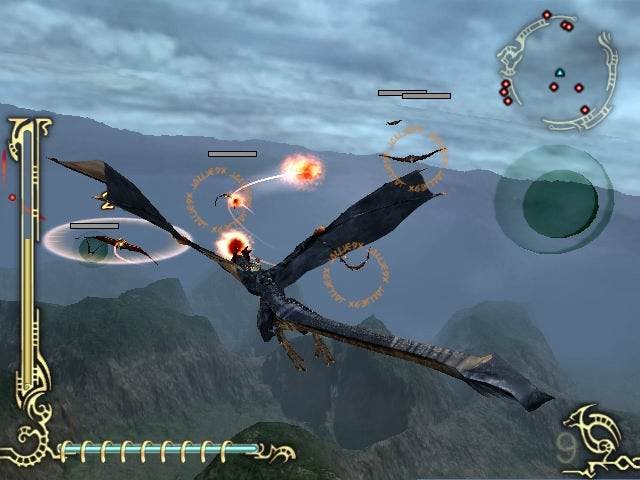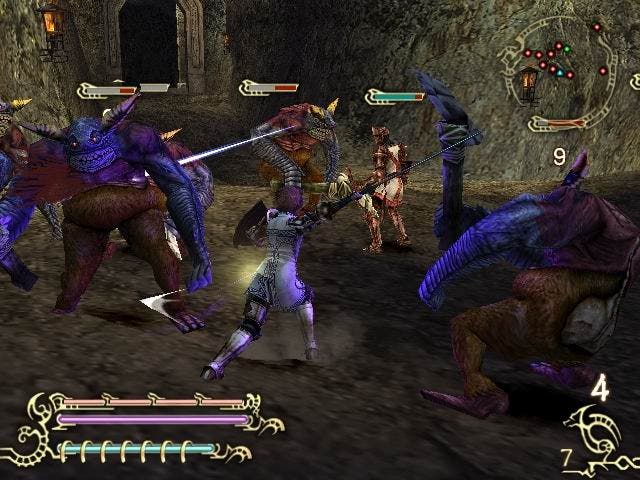Drakengard 2
Flame retardant.
Classical music critics regularly have to review well-known compositions from long dead composers reinterpreted by a contemporary conductor. Be it Fritz Busch orchestrating Mozart's Operas, Serge Koussevitzky recreating Tchaikovsky's symphonies or Sir John Barbirolli's defining interpretations of Mahler, a classical critic essentially weighs one person's interpretation of another's idea.
Likewise, in modern music there's the cover version: Jose Gonzalez transferring The Knife's fizzy bass of Heartbeats to nylon string, Ryan Adams lending melancholic sincerity to Oasis's Wonderwall or Johnny Cash acoustically gravelling his way through the desperation of Nine Inch Nails' self-harming Hurt. The cover version allows artists from different fields to recast well-loved melodies; they put their fingerprint on someone else's handiwork. Sometimes the result is horrible, but often it's mesmerising, casting a sheet of fresh light over all too familiar places.
But there are no cover versions in videogames.

Imagine. Hideo Kojima's Ico: Yorda all khaki-shirt and boot-polish blackened cheeks; John Romero's Kirby Canvas Curse: hot, smoking Gatling gun peeking out from pink fluff holster; Tom Clancy's Super Mario Land: armour-plated Yoshis whispering past night-vision Koopas. No, that couldn't happen. Rather, one publisher just has to rip off another's ideas, try to make them their own, and hope for the best. Arguably, this is a good thing; Shadow of the Colossus might never have worked as a J-pop squeaky Rhythm Action game but still, the chance would be a fine thing.
The Drakengard series, as you might have guessed from this winding but determined introduction, is a cover version in all but name; borrowed gameplay ideas and execution implemented by a publisher trying to carve significance in a genre it has no notable history with. There's no shame there: some of the greatest games have been sneaky tributes. Remarkably though, Drakengard steals from two pockets with one swipe: part Dynasty Warriors action-RPG, part Panzer Dragoon airborne dragon-galleon warfare action this game Pongs back and forth between two originals with metronomic regularity.
The former gameplay casts player as a spinning-top soldier, a blur of weapon shearing swathes of clear space between ten thousand heaving antagonists, each with a line of targeting code tied around their waist pulling them irresistibly towards you. Your whirlwind of juggling judgement knocks limb and armour off at all angles with ever-quickening pace as in-game skills are augmented and out-of-game thumb tap muscle memory locks into place.
The latter mode sees your character leap onto his pet dragon mid-fight to take to the skies, clenching rough hide, locking on targets and blurting flame missiles while lurching and swooping over the clash of foot soldiers 200 metres below. The two gameplay styles segue together with the select button which allows you to hop into and out of the skies at most points (at least on and over open battlefields) in a remarkable display of courageous coding ambition by the developer.

And the cleaved ideology doesn't end there. Your character, Nowe, is a split lead: a weak-armed solider boy carrying the weight of a nation's expectations heavy on slight shoulders. In real life he would be broken by responsibility and frozen with inadequacy. But this is fairytale. Here, legionnaire graduation impending, pubescent lungs burst with warrior aspiration, mind brimming pride and implicit self-significance. His bold confidence is a little nauseating to watch as the weighty, dark (and pretty good) plot unfolds; something made palatable by the acceptance that such attitude would likely afflict anyone first raised by a dragon, then adopted by a king and still befriended by both.
Levelling up too is a split dynamic encouraged through the way new characters are integrated into your team. New members that join Nowe are each represented by a weapon which can be assigned to a quick fire R-Trigger in-battle menu. By switching from, say, sword to spear, you change character, opening up a whole new set of specials and closing the door on others. Any experience you then accrue goes straight into that character's pot so you can build those you like best. They system works well but, as only lead character Nowe can mount the dragon mid-fight, the excitement of experimentation is sadly undermined.
Likewise, this is a split sequel, the narrative separated from its forefather by 18 in-game years, developed by a team clearly determined to break free of the critical prodding the first game received. The overhauling, tweaking and readjusting of each and every gameplay element is obvious and that makes Drakengard 2 the better title. But, the problem here is that the idea is still too closely tied to an epic vision out of kilter with the technical present. In trying to haul what games should be able to do in five years time into today the gameplay cracks and tears, spilling ideas too numerous, bold and voluminous to be contained by mere PS2 architecture. The draw distance is metres so you'll soar hungry for encounter across seemingly empty plains only for a platoon of enemy monsters to fizz into view at the last moment necessitating tight turns and camera wrestling frustration. In the end you'll often just stop watching the main screen instead fixing upon the little map in the corner to guide your character towards hostile red dots that only materialise polygonal just seconds before you lock swords.

And this is a split review. On the one hand the ideas are rudimentarily implemented, the feel of battle is too lightweight, the in-game graphical engine two or three generations of PS2 games too old, the character designs crude, backgrounds cruder, the balance between fighting on ground (where you can take out maybe ten enemies every minute) wholly out of proportion to the airborne option where legions can be obliterated in seconds. But collecting the 90-odd upgradeable weapons is compulsive, the presentation predictably slick for a Square-Enix game and the feel of being a tiny full stop in a gathering narrative storm gripping.
Most of all you can't begrudge its pluckiness. We all love an underdog and, for a game so relatively unrefined and immaturely realised as this to be attempting the things it attempts, is heart-warmingly commendable. That said Drakengard 2 just doesn't have the style or grace or education or expertise or power, to pull it off. Like The Flaming Lips trying their hands at Bohemian Rhapsody you really want the homage to work but, to be honest, it just doesn't. Seeing as Square-Enix chose to call this Drakengard 2 and not Dynasty Warriors Panzer Dragoon edition, it's hard not to knock what essentially comes down to some pretty weak imitation and implementation.








